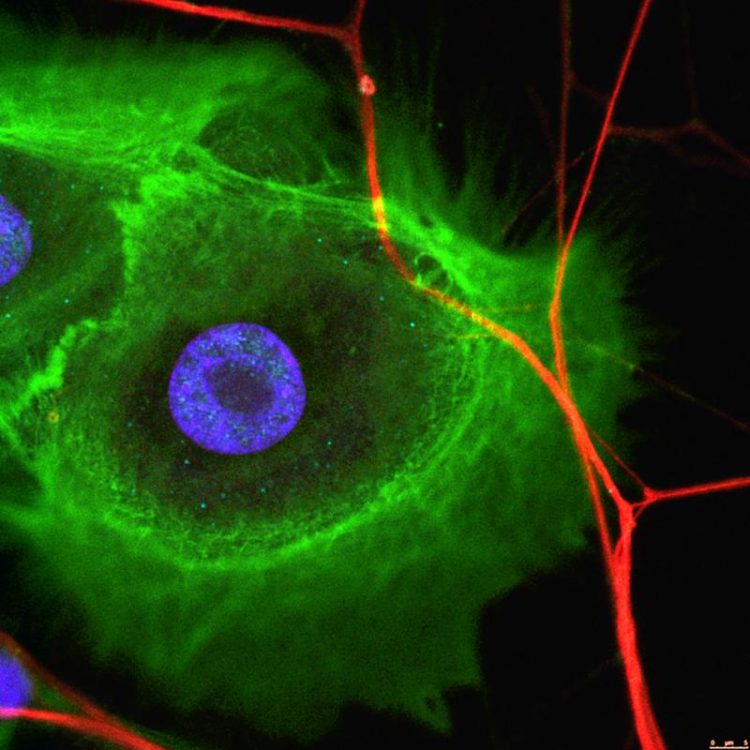Stem Cells and Nerves Interact in Tissue Regeneration and Cancer Progression

Cancer cells (green) are innervated with nerve cells (red). The cell nuclei (blue) are also visible. Institute of Oral Biology, UZH
Stem cells can generate a variety of specific tissues and are increasingly used for clinical applications such as the replacement of bone or cartilage. However, stem cells are also present in cancerous tissues and are involved in cancer progression and metastasis.
Nerves are fundamental for regulating the physiological and regenerative processes involving stem cells. However, little is known about the interactions between stem cells and neurons in regenerating tissues and in cancers.
Comparing stem cell types in tissue regeneration
A team of researchers led by Thimios Mitsiadis, professor at the Institute of Oral Biology of the University of Zurich, has now published two studies that elucidate how stem cells promote neuronal growth in tissue regeneration and in cancer progression.
The first study compared the interaction of neurons with two different human stem cell populations, namely dental pulp stem cells and bone marrow stem cells. Both can differentiate into various cell types such as bone, cartilage and fat cells.
Human bone marrow stem cells are isolated from skeletal bones and are the gold standard for bone regenerative approaches. Extracted teeth are the source of dental pulp stem cells, which represent a promising alternative.
Dental stem cells are highly innervated
Using the “organ-on-a-chip” technology, which relies on small three-dimensional devices mimicking the basic functions of human organs and tissues, the researchers demonstrated that both types of stem cells promoted neuronal growth.
The dental pulp stem cells, however, yielded better results compared to bone marrow stem cells: They induced more elongated neurons, formed dense neuronal networks and established close contacts with nerves.
“Dental stem cells produce specific molecules that are fundamental for the growth and attraction of neurons. Therefore, stem cells are abundantly innervated,” says Mitsiadis. The formation of such extended networks and the establishment of numerous contacts suggest that dental stem cells create functional connections with nerves of the face.
“Therefore, these cells could represent an attractive choice for the regeneration of functional, properly innervated facial tissues,” adds co-author and junior group leader Pierfrancesco Pagella.
Cancer stem cells also recruit neurons
In the second study, the researchers examined the interaction between nerves and cancer stem cells found in ameloblastoma, an aggressive tumour of the mouth. They first demonstrated that ameloblastomas have stem cell properties and are innervated by facial neurons. When ameloblastoma cells were isolated and placed in the “organ-on-a-chip” devices, they retained not only their stem cell properties but also attracted nerves and established contact with them.
“It appears that nerves are fundamental for the survival and function of cancer stem cells,” explains Pagella. “These results create new possibilities for cancer treatment using drugs that modify the communication between neurons and cancer stem cells. We hope this opens unforeseen paths towards effective therapies against cancer,” adds Mitsiadis.
“The combination of advanced molecular and imaging tools and “organ-on-a-chip” technology offers an exciting opportunity to reveal the hidden functions of neurons and their interactions with various stem cell types, in both healthy and pathological conditions.”
Prof. Dr. Thimios Mitsiadis, DDS
Institute of Oral Biology
University of Zurich
Phone: +41 44 634 33 90
E-mail: thimios.mitsiadis@zzm.uzh.ch
Pierfrancesco Pagella, Shayee Miran, Estrela Neto, Ivan Martin, Meriem Lamghari, Thimios A. Mitsiadis. Human dental pulp stem cells exhibit enhanced properties in comparison to human bone marrow stem cells on neurites outgrowth. FASEB J. 25 February 2020. DOI: 10.1096/fj.201902482R.
Pierfrancesco Pagella, Javier Caton, Christian T. Meisel, Thimios A. Mitsiadis. Ameloblastomas exhibit stem cell potential, possess neurotrophic properties, and establish connections with trigeminal neurons. Cells. 6 March 2020. DOI: 10.3390/cells9030644.
https://www.media.uzh.ch/en/Press-Releases/2020/Neuronal-growth.html
Media Contact
All latest news from the category: Life Sciences and Chemistry
Articles and reports from the Life Sciences and chemistry area deal with applied and basic research into modern biology, chemistry and human medicine.
Valuable information can be found on a range of life sciences fields including bacteriology, biochemistry, bionics, bioinformatics, biophysics, biotechnology, genetics, geobotany, human biology, marine biology, microbiology, molecular biology, cellular biology, zoology, bioinorganic chemistry, microchemistry and environmental chemistry.
Newest articles

NASA: Mystery of life’s handedness deepens
The mystery of why life uses molecules with specific orientations has deepened with a NASA-funded discovery that RNA — a key molecule thought to have potentially held the instructions for…

What are the effects of historic lithium mining on water quality?
Study reveals low levels of common contaminants but high levels of other elements in waters associated with an abandoned lithium mine. Lithium ore and mining waste from a historic lithium…

Quantum-inspired design boosts efficiency of heat-to-electricity conversion
Rice engineers take unconventional route to improving thermophotovoltaic systems. Researchers at Rice University have found a new way to improve a key element of thermophotovoltaic (TPV) systems, which convert heat…



